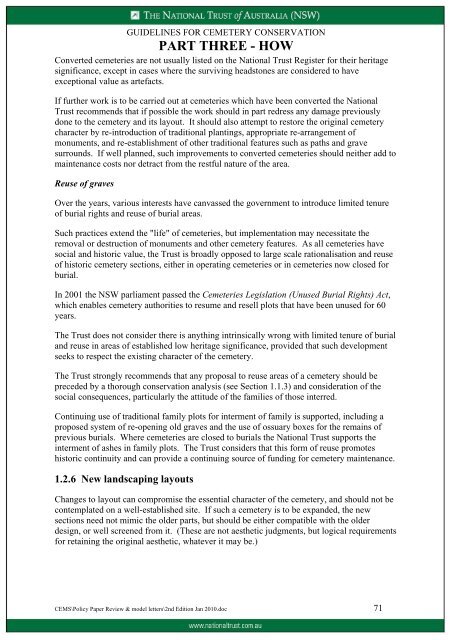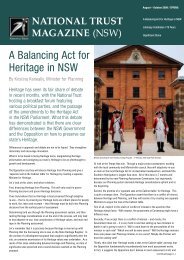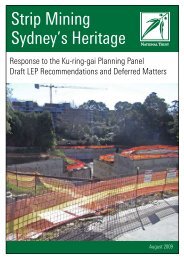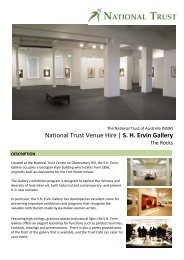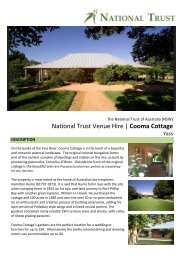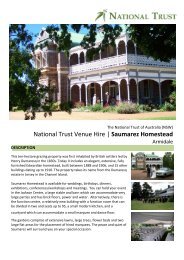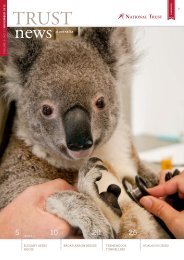Guidelines for Cemetery Conservation - National Trust of Australia
Guidelines for Cemetery Conservation - National Trust of Australia
Guidelines for Cemetery Conservation - National Trust of Australia
Create successful ePaper yourself
Turn your PDF publications into a flip-book with our unique Google optimized e-Paper software.
GUIDELINES FOR CEMETERY CONSERVATION<br />
PART THREE - HOW<br />
Converted cemeteries are not usually listed on the <strong>National</strong> <strong>Trust</strong> Register <strong>for</strong> their heritage<br />
significance, except in cases where the surviving headstones are considered to have<br />
exceptional value as artefacts.<br />
If further work is to be carried out at cemeteries which have been converted the <strong>National</strong><br />
<strong>Trust</strong> recommends that if possible the work should in part redress any damage previously<br />
done to the cemetery and its layout. It should also attempt to restore the original cemetery<br />
character by re-introduction <strong>of</strong> traditional plantings, appropriate re-arrangement <strong>of</strong><br />
monuments, and re-establishment <strong>of</strong> other traditional features such as paths and grave<br />
surrounds. If well planned, such improvements to converted cemeteries should neither add to<br />
maintenance costs nor detract from the restful nature <strong>of</strong> the area.<br />
Reuse <strong>of</strong> graves<br />
Over the years, various interests have canvassed the government to introduce limited tenure<br />
<strong>of</strong> burial rights and reuse <strong>of</strong> burial areas.<br />
Such practices extend the "life" <strong>of</strong> cemeteries, but implementation may necessitate the<br />
removal or destruction <strong>of</strong> monuments and other cemetery features. As all cemeteries have<br />
social and historic value, the <strong>Trust</strong> is broadly opposed to large scale rationalisation and reuse<br />
<strong>of</strong> historic cemetery sections, either in operating cemeteries or in cemeteries now closed <strong>for</strong><br />
burial.<br />
In 2001 the NSW parliament passed the Cemeteries Legislation (Unused Burial Rights) Act,<br />
which enables cemetery authorities to resume and resell plots that have been unused <strong>for</strong> 60<br />
years.<br />
The <strong>Trust</strong> does not consider there is anything intrinsically wrong with limited tenure <strong>of</strong> burial<br />
and reuse in areas <strong>of</strong> established low heritage significance, provided that such development<br />
seeks to respect the existing character <strong>of</strong> the cemetery.<br />
The <strong>Trust</strong> strongly recommends that any proposal to reuse areas <strong>of</strong> a cemetery should be<br />
preceded by a thorough conservation analysis (see Section 1.1.3) and consideration <strong>of</strong> the<br />
social consequences, particularly the attitude <strong>of</strong> the families <strong>of</strong> those interred.<br />
Continuing use <strong>of</strong> traditional family plots <strong>for</strong> interment <strong>of</strong> family is supported, including a<br />
proposed system <strong>of</strong> re-opening old graves and the use <strong>of</strong> ossuary boxes <strong>for</strong> the remains <strong>of</strong><br />
previous burials. Where cemeteries are closed to burials the <strong>National</strong> <strong>Trust</strong> supports the<br />
interment <strong>of</strong> ashes in family plots. The <strong>Trust</strong> considers that this <strong>for</strong>m <strong>of</strong> reuse promotes<br />
historic continuity and can provide a continuing source <strong>of</strong> funding <strong>for</strong> cemetery maintenance.<br />
1.2.6 New landscaping layouts<br />
Changes to layout can compromise the essential character <strong>of</strong> the cemetery, and should not be<br />
contemplated on a well-established site. If such a cemetery is to be expanded, the new<br />
sections need not mimic the older parts, but should be either compatible with the older<br />
design, or well screened from it. (These are not aesthetic judgments, but logical requirements<br />
<strong>for</strong> retaining the original aesthetic, whatever it may be.)<br />
CEMS\Policy Paper Review & model letters\2nd Edition Jan 2010.doc 71


